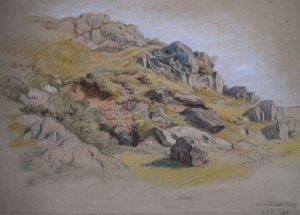Linnell, James Thomas (1820-1905)
The second son of the landscape painter John Linnell, James Thomas Linnell studied at the Royal Academy Schools alongside his two brothers John and William. (His sister Hannah married the artist Samuel Palmer, whose influence can be seen in much of James’s work.) According to a contemporary biographical dictionary, James Thomas Linnell ‘inherited not a little of his father’s talent’, although his palette was perhaps somewhat brighter. He exhibited almost annually at the Royal Academy between 1850 and 1888, at first showing religious subjects in which the landscape predominated; The Temptation in the Wilderness, exhibited in 1850, was followed a year later by Job and the Messengers. By the middle of the decade, however, he was exhibiting mainly landscapes with peasants, farm labourers or children – with titles such as Wheat-Field, Haymakers, Plowing, A Country Road and A Mower whets his Scythe – and it is for these pastoral landscapes that he is best known today. Works by James Linnell are today in the museums of Bradford, Brighton, Cardiff, Gateshead, Harrogate, Leeds, Manchester, Okehampton, Sheffield, Rochdale and Wolverhampton.
Many of James Thomas Linnell’s landscapes were painted in and around the Redstone estate at Redhill, near Reigate in Surrey, which his father John Linnell had acquired in 1851 and where all the members of the family lived. Writing in 1872, one critic noted that ‘James Thomas Linnell…is entitled to share with his brother William the estimation in which their pictures are held by the amateur and collector, sometimes rivalling even those of his father.
Showing the single result
